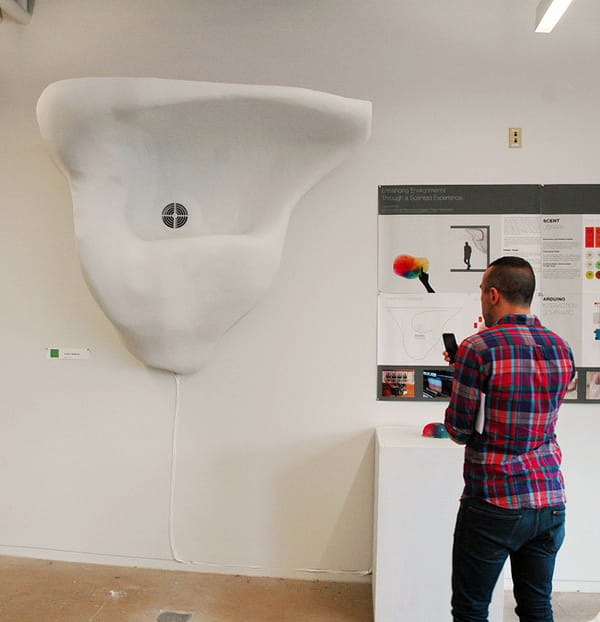Drexel Students Design Visions of the Future

- How and When Could AI Be Used in Emergency Medicine?
- Drexel Receives $1.4 Million Grant to Establish Hub for Literacy Reform
- Drexel Public Health Researchers Lead $3.7 Million Study Looking at Impact of Federal Housing Assistance on Health Care for Chronic Conditions
- Drexel Co-ops Learn the Art of Conservation and Collections Care

The future isn’t as hard to imagine as you might think. At least not for these six graduate students who recently completed a year-long project creating what they called “near-future speculations,” or prototypes of designs that could plausibly enter the marketplace in the next 5-10 years.
In the world envisaged by these Drexel students, future products that may hit the market include countertops that change color when they detect bacteria, a bed that nudges you when you’re snoring and a scarf that can help you find your way through the city.
The students, who are all pursuing their master’s degrees in the Interior Architecture + Design program in Drexel University’s Antoinette Westphal College of Media Arts & Design, were tasked with the project as part of a residency in Drexel’s Design Futures Lab, a trans-disciplinary design research group led by assistant professor Nicole Koltick.
They collaborated with a variety of specialists in fields such as ecology, biology, biomedical engineering, interactive design and computer science while researching their concepts
The students then brought their visions to life through full-scale prototypes of objects, experiences and environments, which will be on display at Drexel from July 5-21. Visitors are encouraged to interact with and immerse themselves in the futuristic designs.
“This project epitomizes the Design Futures Lab’s mission to use design-led multidisciplinary research to produce innovative results that can be applied practically across a variety of domains,” said Koltick. “These students successfully combined design, art, science and technology with narratives in order to solve problems in our everyday lives in the near future.”
The exhibit will be held at the Leonard Pearlstein Gallery in the URBN Center Annex (3401 Filbert St.) from Friday, July 5 – Saturday, July 21. A reception will take place in the gallery on Tuesday, July 9, from 6 – 9 p.m. The gallery is free and open to the public Monday – Friday, 11 a.m. – 5 p.m.
The projects to be displayed include:
Technology at the Threshold” by Megan Mitchell
"Technology on the Threshold" by Megan Mitchell
In this igloo-like decompression chamber, visitors will experience true reprieve from their over-scheduled, over-connected lives as the colored, shifting lights and flowing air provide a refreshing, cleansing experience. The project simulates a Faraday cage, which is an enclosure that blocks electromagnetic signals, including cell phone and wireless information, from being transmitted. Shedding layers of stress, digital connection and distractions of the outside world, this entry processional experience re-orients the participant to the present time and place. This research addresses the ability of an interactive threshold space to assist individuals in transitioning from one set of experiences, expectations and activities to another.
“Memory Prosthetic” by Sarah Moores
“Synthetic Biology: The Future of Adaptive Living Spaces” by Tashia Tucker
This wearable device records an audio track when there is a detectable physiological change in the wearer, such as when the wearer becomes agitated or excited. After recording events with the assistance of biofeedback, users enter a listening pod which plays back the audio to enhance meditative reflection on selected moments throughout the day. This thesis speculates on how memories form through emotional connections to events, and the integration of technology with our biological responses that enhance our awareness of these connections.
“Synthetic Biology: The Future of Adaptive Living Spaces” by Tashia Tucker
"Sculpted Interactive Terrain" by Tashia Tucker
This project considers the practical benefits of a countertop, floor or wall surface that can detect pesticides, pathogens and allergens and then alert us to their presence. The collection of three dynamic surfaces offers a glimpse into the interdisciplinary field of synthetic biology and the future evolution of living materials. It examines how biologically embedded materials could look and function in the future through the use of micro-processing, depth imaging, a multi-pedal sensor map and silicone casting.
“Sculpted Interactive Terrain” by Katie McHugh
This “smart bed” takes an integrated approach to exploring potential connections between human experiences and technological advances within one’s sleeping environment. The project speculates on a possible future interactive sleep environment, anticipating the onset of billions of sensors in our environment. This prototype is designed to allow the participant to discover new possibilities of inhabiting future environments.
“Ambient Scent Communication” by Laura Nejman
Controller for the "Ambient Scent - Communication" device created by Laura Nejman
This scent communication device explores the use of scent to improve human connection and emotional states. The prototype explores how we can manipulate our emotional connections to one another through the use of scents that are linked to positive memories. By using the subconscious reaction to scent and pulling communication away from the screens of computers and phones, the prototype explores a more nuanced way to communicate within our environments.
“Deviant Wear: Remediating Technology and the Urban Experience” by Kim Brown
“Deviant Wear” is a wearable project in which visitors will don a jacket and a series of scarves that serve as urban way-finding devices. These items provide an audio overlay of information when in the presence of sensory “graffiti” that have been installed throughout the city. This project examines strategies for encouraging ambulatory exploration of the urban landscape through experimental prototyping with environmental sensors, physical feedback and audio graffiti.
About the Design Futures Lab
The Design Futures Lab is a trans-disciplinary design research group led by Nicole Koltick, an assistant professor in Interior Architecture + Design. The lab explores applied design research through a variety of approaches, including generative design processes and digital fabrication techniques such as 3D printing, laser cutting and CNC milling; enhanced interaction scenarios which deploy embedded technology including a variety of electronics, sensors and microcontrollers; and the pursuit of tactile material, technological and procedural innovations. Core missions of the lab include the synthesis of theory, procedures and technology from a variety of disciplines into compelling future design scenarios; and the transition of speculative ideas into designed objects, experiences and environments that people can be tangibly interact with.
Drexel News is produced by
University Marketing and Communications.